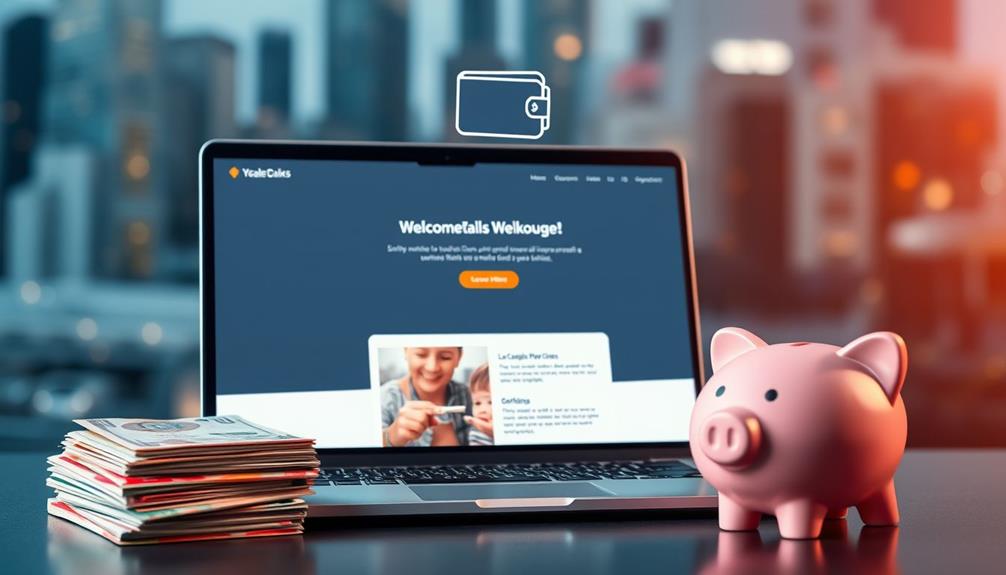The cost of a professional website can range from $1,000 to $100,000, depending on various factors. You’ll need to ponder the intricacy of your desired site, including features like e-commerce capabilities or custom designs. The designer’s experience level plays a vital role, as more experienced professionals often charge higher rates but may complete projects more efficiently. Your timeline and urgency can also impact pricing, with expedited services typically commanding a premium. When budgeting, don’t forget to account for ongoing maintenance and updates, which are indispensable for keeping your site secure and relevant. Understanding these factors will help you make an informed decision about your website investment.
Cost of Website Design

When considering the cost of website design, you’ll need to account for several key factors that substantially influence pricing. The complexity of your desired features, such as e-commerce capabilities or custom functionality, will play a major role in determining the overall cost.
Additionally, the experience level of the designer you choose and the urgency of your project’s timeline can impact the final price, with more seasoned professionals and tighter deadlines typically demanding higher fees.
Complexity and Features
The complexity and features of your website play an essential role in determining its cost. As a member of the online community, you’ll want to ponder which elements are indispensable for your site’s success. Basic websites with simple layouts and minimal interactivity will naturally cost less than those with advanced functionalities.
Do you need e-commerce capabilities, user accounts, or a content management system? These features can significantly increase the price. Custom designs, animations, and interactive elements also add to the intricacy and, consequently, the cost. Remember, more complex sites often require additional development time and expertise.
Consider your long-term goals: Will you need scalability for future growth? How about integrations with third-party services or APIs? These factors can impact the initial investment but may save you money in the long run. It’s pivotal to balance your current needs with potential future requirements.
When discussing your project with developers, be specific about the features you desire. This clarity will help them provide more accurate estimates and certify you’re not paying for unnecessary complexities. Ultimately, the right combination of features will create a website that serves your audience effectively while fitting within your budget constraints.
Designer’s Experience Level
Building on the notion of complexity, another key factor in website cost is the designer’s experience level. As you consider your options, you’ll find that more experienced designers typically command higher rates. Why? They’ve honed their skills over years, mastering the intricacies of user experience, responsive design, and cutting-edge technologies. These seasoned professionals can often complete projects more efficiently and with fewer revisions, potentially saving you time and frustration in the long run.
However, don’t discount less experienced designers entirely. They may offer more competitive rates and bring fresh, innovative ideas to the table. The key is to assess your project’s needs and budget constraints. Are you looking for a simple, straightforward site, or do you require complex functionality and custom features? How important is industry-specific expertise to your project’s success? Remember, a designer’s portfolio speaks volumes about their capabilities. Examine their past work critically, asking yourself: Does it align with your vision? Does it demonstrate the level of sophistication you’re seeking? By carefully weighing experience against cost, you’ll be better equipped to make an informed decision that balances quality and affordability.
Timeline and Urgency
With website design, time is often money. When you’re in a rush to launch your site, you’ll likely pay a premium for expedited service. Designers may charge higher rates for tight deadlines, as they might need to work overtime or postpone other projects to accommodate your timeline. Conversely, if you have a flexible schedule, you might secure more competitive pricing.
Consider your project’s urgency and how it aligns with your budget. Are you launching a time-sensitive campaign or preparing for a major event? If so, factor in the cost of prioritized development. On the other hand, if you can afford to wait, you might benefit from off-peak rates or package deals. Some designers offer discounts for projects with longer timelines, as it allows them to balance their workload more effectively.
How quickly do you need your website completed? Is there room for negotiation on the delivery date? These questions can greatly impact your final cost. Remember, rushing a project may compromise quality, so weigh the trade-offs carefully. Ultimately, finding the right balance between timeline, budget, and quality will guarantee you get the best value for your investment.
Benefits

Investing in a professional website offers numerous benefits that can substantially impact your business’s success. You’ll establish a polished online presence and boost your brand’s credibility, which can lead to increased trust among potential customers and partners.
In addition, a well-designed website enhances user experience and improves search engine rankings, potentially driving more organic traffic to your digital doorstep and increasing your chances of converting visitors into customers.
Professional Online Presence
A professional online presence provides numerous benefits for businesses and individuals alike. When you invest in a well-designed website, you’re creating a digital storefront that represents your brand 24/7. This constant availability allows potential customers to explore your offerings, learn about your values, and connect with your business at their convenience.
Your website serves as a central hub for your online identity, establishing credibility and trust with your audience. It’s often the first point of contact for new customers, making it essential to present a polished, user-friendly interface. A professional site can set you apart from competitors, showcasing your expertise and unique selling points.
Moreover, a well-crafted website improves your visibility in search engine results, helping you reach a wider audience. It provides a platform for content marketing, allowing you to share valuable information and establish yourself as an industry leader. Have you considered how a professional online presence could enhance your networking opportunities? By incorporating social media links and contact forms, you’re opening doors to valuable connections and partnerships that can propel your business forward.
Increased Brand Credibility
Establishing a professional website markedly boosts your brand’s credibility. In today’s digital landscape, consumers often form their first impressions of your business online. A well-designed, functional website conveys competence, reliability, and trustworthiness, essential qualities for building a loyal customer base.
When you invest in a high-quality website, you’re not just creating an online presence; you’re cultivating a digital storefront that represents your brand 24/7. This constant availability demonstrates your commitment to accessibility and customer service.
Furthermore, a professional website allows you to showcase your expertise through informative content, case studies, and testimonials. Have you considered how a blog section could position you as an industry thought leader?
Your website also serves as a central hub for your marketing efforts. By integrating social media feeds, email sign-ups, and contact forms, you create multiple touchpoints for potential clients. This cohesive online strategy reinforces your brand’s legitimacy and professionalism.
Enhanced User Experience
Consistently, enhanced user experience stands out as a significant benefit of investing in a quality website. When you prioritize user experience, you’re not just creating a digital presence; you’re crafting an inviting, intuitive space for your audience. A well-designed website guarantees visitors can easily navigate, find information, and complete desired actions, whether it’s making a purchase or submitting an inquiry.
Consider how a streamlined interface, fast loading times, and mobile responsiveness contribute to a positive user experience. These elements work together to reduce bounce rates and increase engagement, ultimately leading to higher conversion rates. Have you thought about how intuitive menu structures and clear calls-to-action can guide users through your site effortlessly? By investing in these features, you’re demonstrating respect for your visitors’ time and needs, fostering a sense of belonging and trust.
Moreover, an enhanced user experience extends beyond aesthetics. It encompasses factors such as accessibility for users with disabilities, personalized content delivery, and seamless integration across devices. Isn’t it vital to ensure that every visitor feels welcomed and valued when interacting with your brand online?
Improved Search Rankings
While user experience is fundamental, improved search rankings play an equally essential role in a website’s success. When you invest in a professionally designed website, you’re not just paying for aesthetic appeal; you’re investing in your online visibility. Search engines like Google use complex algorithms to determine which websites appear at the top of search results. A well-optimized site can drastically boost your chances of being found by potential customers.
Professional web designers understand the intricacies of search engine optimization (SEO). They’ll implement key strategies, such as optimizing meta tags, creating search-friendly URLs, and ensuring your site’s structure is easily crawlable by search engines. But it doesn’t stop there. They’ll also focus on content optimization, incorporating relevant keywords and creating high-quality, engaging content that search engines love. Additionally, they’ll guarantee your site is mobile-friendly and loads quickly, both vital factors in search rankings. Remember, a higher ranking means more organic traffic, which can lead to increased conversions and revenue. Isn’t it worth investing in a website that not only looks great but also performs well in search results?
Website Maintenance and Updates

When considering the cost of a website, you’ll need to factor in ongoing expenses for maintenance and updates. These costs typically include regular maintenance, content updates, and security patch installations, which are vital for keeping your site running smoothly and securely. To help you understand the potential expenses, consider the following breakdown of common maintenance and update costs:
| Service Type | Frequency | Estimated Cost Range |
|---|---|---|
| Regular Maintenance | Monthly | $50 – $500 |
| Content Updates | As Needed | $75 – $300 per update |
| Security Patches | Quarterly | $100 – $1000 |
| Performance Optimization | Bi-annually | $250 – $2000 |
Regular Maintenance Costs
After launching your website, you’ll need to budget for ongoing maintenance costs. These regular expenses are vital to ensuring your site remains functional, secure, and up-to-date, keeping you connected with your audience. Typical maintenance tasks include software updates, security patches, content updates, and performance optimization.
On average, you can expect to pay between $50 and $200 per month for basic maintenance services. However, costs may vary depending on your website’s complexity and specific needs. For instance, e-commerce sites or those with frequent content updates might require more extensive maintenance, potentially increasing costs.
What factors influence maintenance expenses? Consider the following:
- Frequency of updates: How often do you need content changes or software updates?
- Security requirements: Do you handle sensitive data that requires additional protection?
- Backup and recovery services: How imperative is data preservation for your business?
- Performance monitoring: Do you need regular speed and uptime checks?
- Technical support: What level of assistance do you require for troubleshooting?
Content Update Pricing
In addition to regular maintenance, you’ll need to ponder the cost of content updates for your website. Keeping your site fresh and relevant is vital for maintaining your audience’s interest and improving search engine rankings. Content update pricing can vary widely, depending on the complexity and frequency of updates required.
Many web developers offer content update packages, which may include a set number of text revisions, image replacements, or blog posts per month. These packages typically range from $100 to $500 monthly, depending on the scope of work. For more extensive updates, such as adding new pages or restructuring sections, you might expect to pay hourly rates between $50 and $150.
When considering content update pricing, ask yourself: How often will you need updates? What type of content requires frequent changes? Will you need specialized content, like infographics or videos? By answering these questions, you’ll better understand your ongoing content needs and can budget accordingly. Remember, investing in regular content updates isn’t just an expense; it’s a strategy to keep your website engaging, informative, and competitive in your industry.
Security Patch Expenses
While content updates keep your site fresh, security patches guarantee it remains protected. As a website owner, you’ll need to factor in the costs associated with these indispensable updates.
Security patches are essential for safeguarding your site against potential threats and vulnerabilities that could compromise your data and your visitors’ trust.
The expense of security patches can vary depending on the complexity of your website and the frequency of updates required. On average, you might expect to pay between $50 to $200 per month for regular security maintenance. This cost typically includes monitoring for potential threats, applying necessary patches, and ensuring your site’s overall security integrity.
Why is this investment necessary? Cybersecurity threats are constantly evolving, and without regular updates, your site becomes an easy target for hackers. By staying current with security patches, you’re not only protecting your own interests but also demonstrating to your audience that you value their safety and privacy. Remember, a secure website builds credibility and fosters a sense of belonging among your users. Can you afford to skimp on security when your reputation is at stake?
Frequently Asked Questions
How Long Does It Typically Take to Design and Launch a Website?
You’ll find that website timelines vary widely. For a simple site, you could be up and running in a few weeks. More complex projects may take several months. It’s all about your unique needs and the designer’s workload.
Can I Use My Own Domain Name With a Newly Designed Website?
You can use your own domain name with your newly designed website. It’s a great way to maintain your brand identity. Just make sure to update your domain’s DNS settings to point to your new site’s hosting.
What Happens if I’m Not Satisfied With the Final Website Design?
If you’re not happy with the final design, don’t worry! You’re part of the process. Speak up and communicate your concerns. Most designers want you to love your site and will work with you to make necessary adjustments.
Are There Any Hidden Costs Associated With Website Creation?
You’ll want to be aware of potential hidden costs. They can include domain registration, hosting fees, SSL certificates, and ongoing maintenance. Don’t worry, though—a reputable designer will be upfront about all expenses, keeping you in the loop.
Do I Need to Provide My Own Content for the Website?
You’ll typically need to provide your own content for your website. It’s your unique voice that’ll make your site stand out! Don’t worry though, many designers can guide you through the content creation process if you’re feeling stuck.







